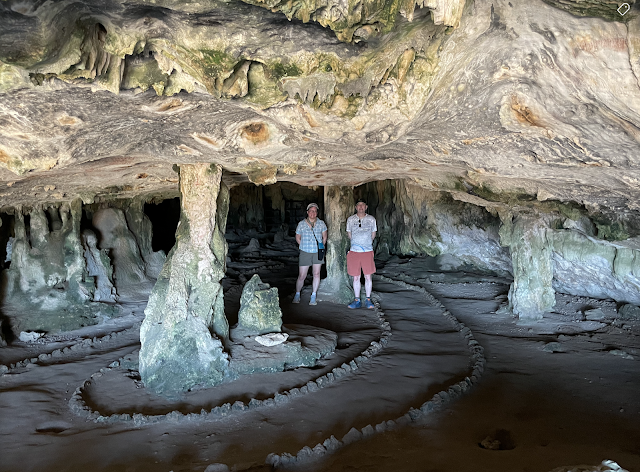Exploring Aruba 3: Caves of Arikok & Madame Janette
Sunny breezy Aruba is truly a delight to visit! We drove the main Arikok National Park road for expansive views of cactus-laden hills rolling to white sand dunes with the blue ocean beyond. While visiting Boca Prins, Fontein Cave and Quadirikiri Cave, we spotted colorful whiptail lizards in the sun, under bushes and in the caves along with a few bats. After exiting the park past the windmills, we found ourselves back in Seroe Colorado. A truly wonderful and delicious outdoor dinner at Madame Jeanette wrapped up our second full day in Aruba.
 |
| Fontein Cave |
 |
| Boca Prins Beach |
 |
| Dagger cactus |
 |
| Entrance to Quadirikiri |
The Arikok Park Road
View Point
 |
| Boca Prins Dunes in distance. Note the transition from cactus-shrub to a more barren, brown landscape. |
Boca Prins
 |
| My husband at the top of the dune provides a sense of how large they are. |
 |
| Seagrape and other green vegetation along the Rooi Tambu near Dos Playa. |
 |
| Steps down to Boca Prins beach. |
 |
| View from cave-like overhang at Boca Prins Beach. |
 |
| This cutaway view shows the seagrape tree trunk that supports all the leaves on top. |
Fontein Cave
 |
| Red Arikok artwork mostly obscured by overlying graffiti. |
Quadirikiri Cave
 |
| Drips of water quivering at the end of tiny stalagtites. |
Vader Piet Wind Farm
Kamini's Kitchen
Madame Janette
 |
| Mangojito |
 |
| Lychee martini |
 |
| Almond crusted grouper |
 |
| Soy honey glazed sea bass |
 |
| Creamy lobster ravioli |
 |
| Huge coconut cake and tres leches cake |
 |
| Chocolate souflle and pumpkin seed gelato: coconut cake with strawberry gelato |
All Rights Reserved. Contact admin@love2chow.com for permissions.
















































0 comments